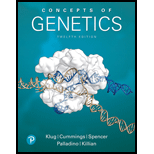
Concepts of Genetics (12th Edition)
12th Edition
ISBN: 9780134604718
Author: William S. Klug, Michael R. Cummings, Charlotte A. Spencer, Michael A. Palladino, Darrell Killian
Publisher: PEARSON
expand_more
expand_more
format_list_bulleted
Concept explainers
Textbook Question
Chapter 26, Problem 1PDQ
HOW DO WE KNOW?
Population geneticists study changes in the nature and amount of
- (a) How do we know how much genetic variation is in a population?
- (b) How do geneticists detect the presence of genetic variation as different alleles in a population?
- (c) How do we know whether the genetic structure of a population is static or dynamic?
- (d) How do we know when populations have diverged to the point that they form two different species?
- (e) How do we know the age of the last common ancestor shared by two species?
Expert Solution & Answer
Want to see the full answer?
Check out a sample textbook solution
Students have asked these similar questions
Generate one question that requires a Punnet Squre to solve the question. Then show how you calculate the possibilities of genotype and phenotype
Briefly state the physical meaning of the electrocapillary equation (Lippman equation).
Explain in a small summary how:
What genetic information can be obtained from a Punnet square? What genetic information cannot be determined from a Punnet square?
Why might a Punnet Square be beneficial to understanding genetics/inheritance?
Chapter 26 Solutions
Concepts of Genetics (12th Edition)
Ch. 26 - The ability to taste the compound...Ch. 26 - Determine whether the following two sets of data...Ch. 26 - If the albino phenotype occurs in 1/10,000...Ch. 26 - A prospective groom, who is unaffected, has a...Ch. 26 - In a region of Quebec, Canada, 1 in 22 people are...Ch. 26 - Critics argue that a uniform panel of disorders...Ch. 26 - Others argue that the current testing system...Ch. 26 - HOW DO WE KNOW? Population geneticists study...Ch. 26 - CONCEPT QUESTION Read the Chapter Concepts list on...Ch. 26 - Price et al. [(1999).J. Bacteriol181:2358-2362)...
Ch. 26 - The genetic difference between two Drosophila...Ch. 26 - The use of nucleotide sequence data to measure...Ch. 26 - Prob. 6PDQCh. 26 - What must be assumed in order to validate the...Ch. 26 - In a population where only the total number of...Ch. 26 - If 4 percent of a population in equilibrium...Ch. 26 - Consider a population in which the frequency of...Ch. 26 - If the initial allele frequencies are p = 0.5 and...Ch. 26 - Under what circumstances might a lethal dominant...Ch. 26 - Assume that a recessive autosomal disorder occurs...Ch. 26 - One of the first Mendelian traits identified in...Ch. 26 - Describe how populations with substantial genetic...Ch. 26 - Achondroplasia is a dominant trait that causes a...Ch. 26 - Prob. 17PDQCh. 26 - Prob. 18PDQCh. 26 - A botanist studying water lilies in an isolated...Ch. 26 - A farmer plants transgenic Bt corn that is...Ch. 26 - In an isolated population of 50 desert bighorn...Ch. 26 - To increase genetic diversity in the bighorn sheep...Ch. 26 - What genetic changes take place during speciation?Ch. 26 - Some critics have warned that the use of gene...Ch. 26 - Prob. 25PDQCh. 26 - What are the two groups of reproductive isolating...Ch. 26 - A form of dwarfism known as Ellisvan Creveld...Ch. 26 - The original source of new alleles, upon which...Ch. 26 - A number of comparisons of nucleotide sequences...Ch. 26 - Shown below are two homologous lengths of the...Ch. 26 - Recent reconstructions of evolutionary history are...
Knowledge Booster
Learn more about
Need a deep-dive on the concept behind this application? Look no further. Learn more about this topic, biology and related others by exploring similar questions and additional content below.Similar questions
- In a small summary write down:arrow_forwardNot part of a graded assignment, from a past midtermarrow_forwardNoggin mutation: The mouse, one of the phenotypic consequences of Noggin mutationis mispatterning of the spinal cord, in the posterior region of the mouse embryo, suchthat in the hindlimb region the more ventral fates are lost, and the dorsal Pax3 domain isexpanded. (this experiment is not in the lectures).a. Hypothesis for why: What would be your hypothesis for why the ventral fatesare lost and dorsal fates expanded? Include in your answer the words notochord,BMP, SHH and either (or both of) surface ectoderm or lateral plate mesodermarrow_forward
arrow_back_ios
SEE MORE QUESTIONS
arrow_forward_ios
Recommended textbooks for you
 Human Heredity: Principles and Issues (MindTap Co...BiologyISBN:9781305251052Author:Michael CummingsPublisher:Cengage Learning
Human Heredity: Principles and Issues (MindTap Co...BiologyISBN:9781305251052Author:Michael CummingsPublisher:Cengage Learning Biology (MindTap Course List)BiologyISBN:9781337392938Author:Eldra Solomon, Charles Martin, Diana W. Martin, Linda R. BergPublisher:Cengage Learning
Biology (MindTap Course List)BiologyISBN:9781337392938Author:Eldra Solomon, Charles Martin, Diana W. Martin, Linda R. BergPublisher:Cengage Learning Biology: The Dynamic Science (MindTap Course List)BiologyISBN:9781305389892Author:Peter J. Russell, Paul E. Hertz, Beverly McMillanPublisher:Cengage Learning
Biology: The Dynamic Science (MindTap Course List)BiologyISBN:9781305389892Author:Peter J. Russell, Paul E. Hertz, Beverly McMillanPublisher:Cengage Learning Human Biology (MindTap Course List)BiologyISBN:9781305112100Author:Cecie Starr, Beverly McMillanPublisher:Cengage Learning
Human Biology (MindTap Course List)BiologyISBN:9781305112100Author:Cecie Starr, Beverly McMillanPublisher:Cengage Learning Concepts of BiologyBiologyISBN:9781938168116Author:Samantha Fowler, Rebecca Roush, James WisePublisher:OpenStax College
Concepts of BiologyBiologyISBN:9781938168116Author:Samantha Fowler, Rebecca Roush, James WisePublisher:OpenStax College

Human Heredity: Principles and Issues (MindTap Co...
Biology
ISBN:9781305251052
Author:Michael Cummings
Publisher:Cengage Learning

Biology (MindTap Course List)
Biology
ISBN:9781337392938
Author:Eldra Solomon, Charles Martin, Diana W. Martin, Linda R. Berg
Publisher:Cengage Learning

Biology: The Dynamic Science (MindTap Course List)
Biology
ISBN:9781305389892
Author:Peter J. Russell, Paul E. Hertz, Beverly McMillan
Publisher:Cengage Learning

Human Biology (MindTap Course List)
Biology
ISBN:9781305112100
Author:Cecie Starr, Beverly McMillan
Publisher:Cengage Learning

Concepts of Biology
Biology
ISBN:9781938168116
Author:Samantha Fowler, Rebecca Roush, James Wise
Publisher:OpenStax College

What is Evolution?; Author: Stated Clearly;https://www.youtube.com/watch?v=GhHOjC4oxh8;License: Standard Youtube License